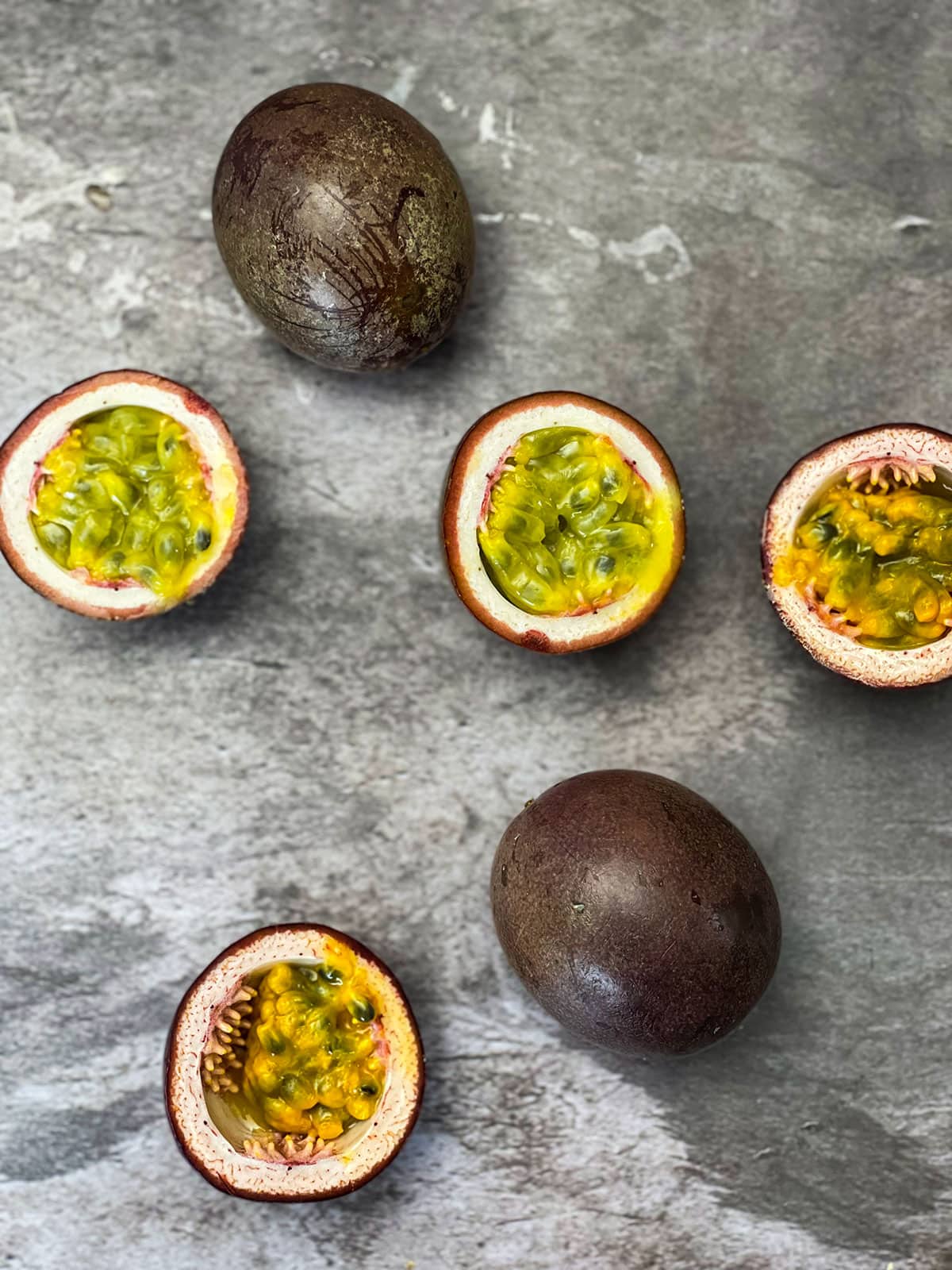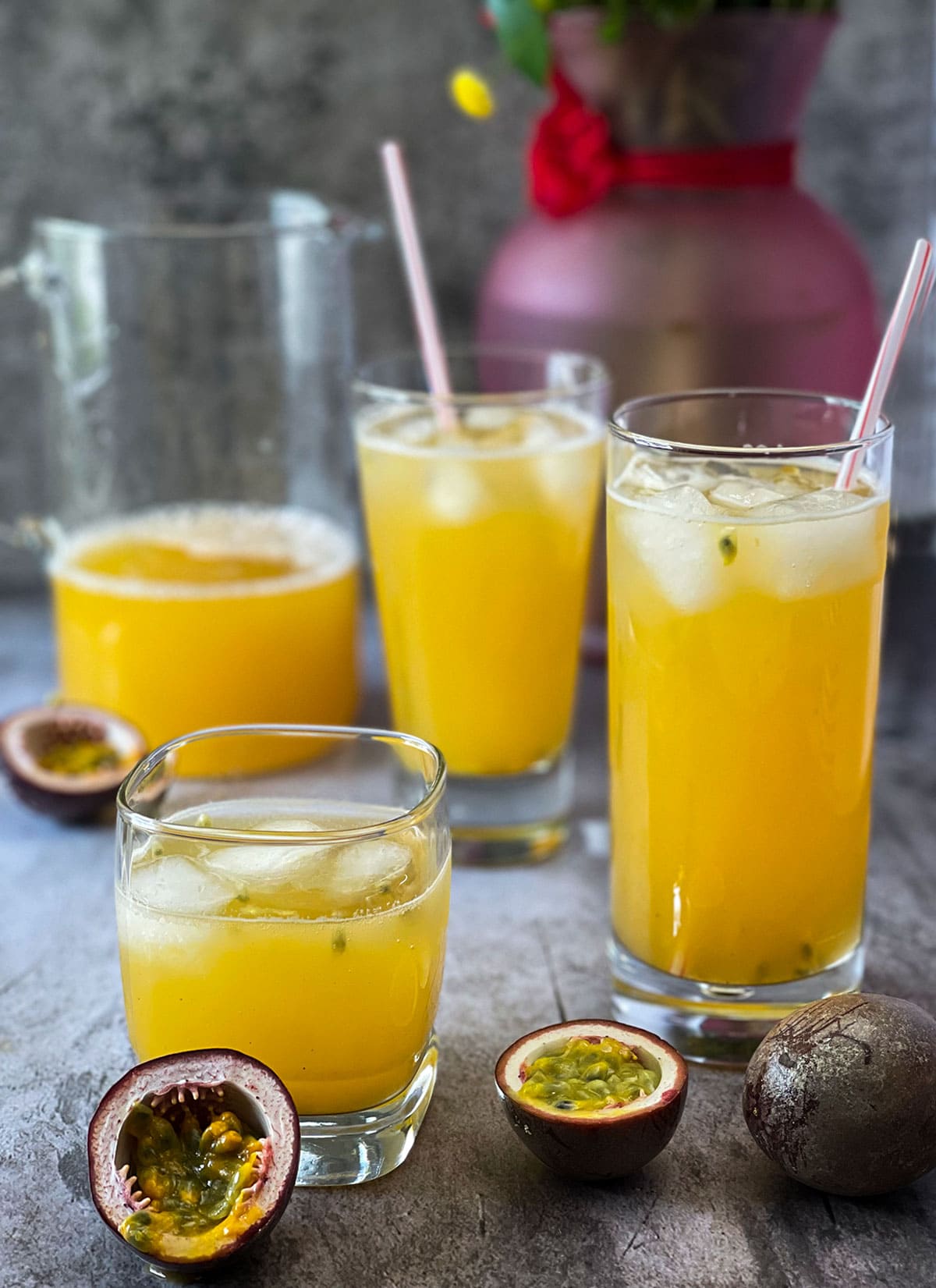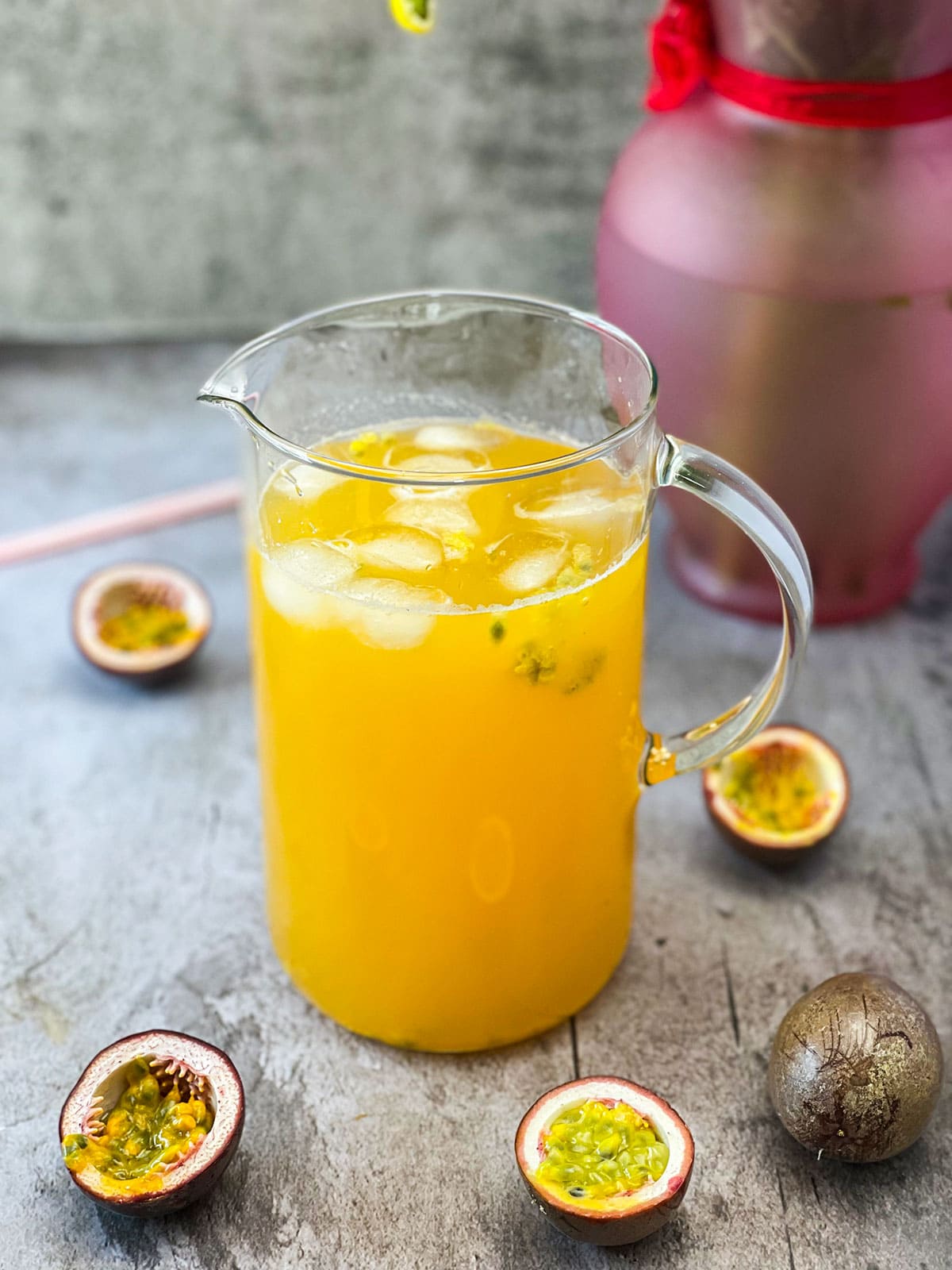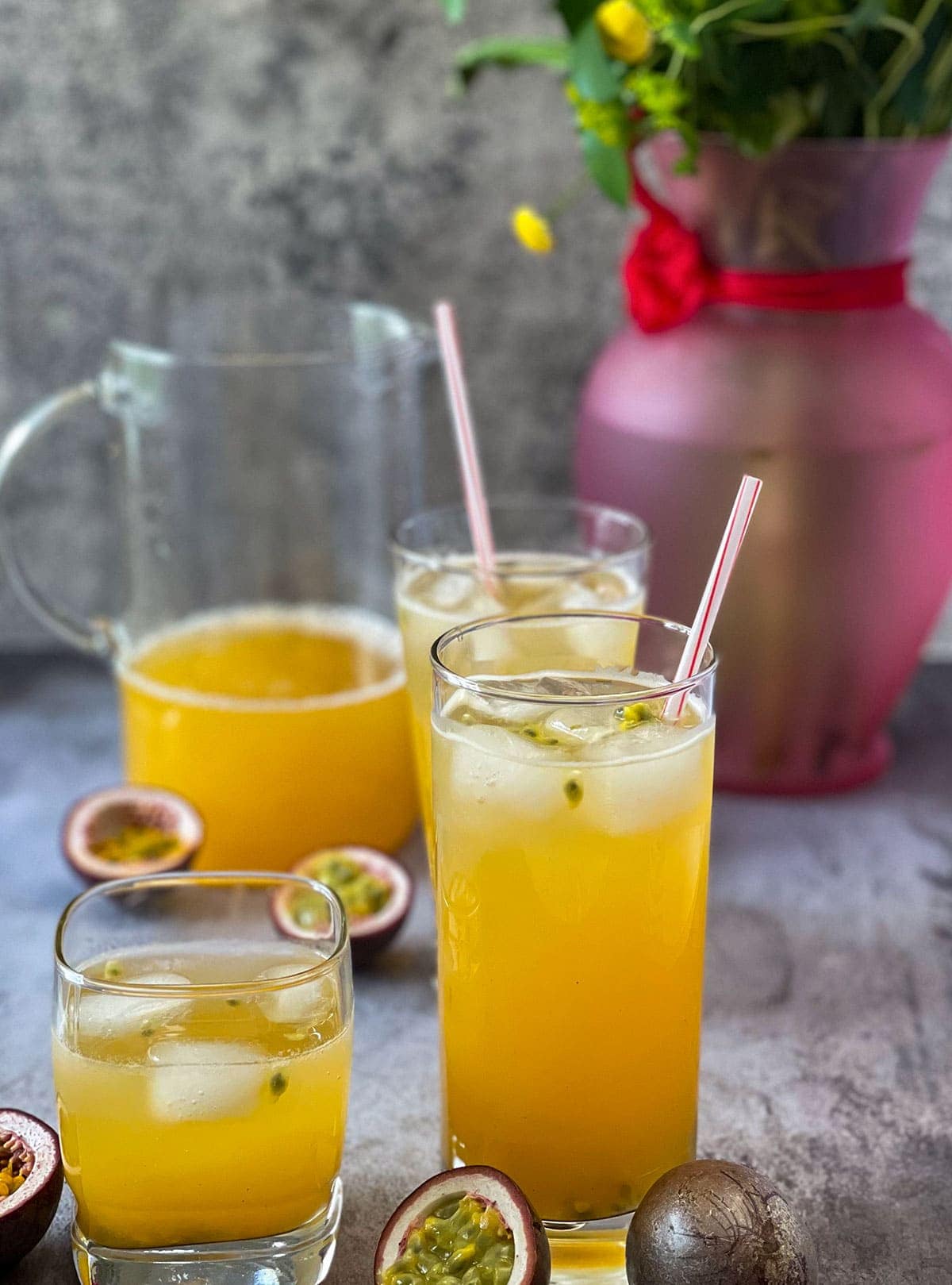Passion Fruit Juice
Passion Fruit Juice is a delicious and healthful drink that is high in vitamins, antioxidants, and fiber. It’s so simple to make that it’ll be ready in just 15 minutes! A great summer drink that your family will enjoy all year long! Passion fruit’s pleasantly sour and tangy flavor is well known, and its chock-full of nutritional elements derived from plants promote good health. Because of its beneficial characteristics, the fruit has grown in popularity among health-conscious individuals.
There is a lot to learn about passion fruit, including its nutritional worth and health advantages, so let’s get started!
Also, check out, Ginger Juice and Pineapple Mango Juice

What Is Passion Fruit?
Passion fruit is a Brazilian native. Passion fruit, also called Passiflora, is a tropical flowering vine that thrives in warm, humid climates. In the Dominican Republic, it’s called Chinola, and in Spanish, Maracuya. There is a soft pulp in the hard rind with many edible seeds. There are so many ways to use this fruit that it makes everything taste better when you add it. The seeds and pulp can also be eaten, juiced, or added to other juices and shakes.
The color and size of passion fruit vary depending on the variety, and the most common varieties on the market are golden yellow and purple. Passiflora flavicarpa has golden yellow skin and is big, oval, or spherical in shape.
Passiflora edulis is a little oval-shaped variant with purple skin. Purple ones come from South American countries when it comes to passion fruit, and Golden yellow ones are more common in Asia and Australia. Despite the fact that passion is a tropical fruit, several types can thrive in sub-tropical climates, and this is the main reason they may be found in practically every country.
The fruit has also grown in popularity as a result of its high concentration of strong antioxidants and other elements that have numerous health advantages. Let’s examine the nutritional composition of passion fruit and its potential health advantages. Read More.

Nutrients
Passion fruit is high in fiber, vitamin C, & provitamin A, among other nutrients.
It’s also high in plant chemicals that are good for you, such as carotenoids and polyphenols.
Iron from plants is typically poorly absorbed by the human body. However, passion fruit contains a high concentration of vitamin C, which has been shown to improve iron absorption.
Indeed, one study discovered that passion fruit contained more polyphenols than a variety of other tropical fruits, such as banana, mango, papaya, lychee, and pineapple.
Passion fruit also contains a little quantity of iron. Read More.
Antioxidant-Rich Source
Passion fruit has a zesty flavor with a sweet tang. It is high in antioxidants, which aid in the removal of damaging free radicals from your body. Antioxidants are essential for the proper functioning of your immune system, as they aid in the prevention of disease.
Antioxidants, according to specialists, are important for maintaining proper blood flow, particularly in the nervous and brain system, as well as warding off harmful pollutants in the blood.
Both inflammation and stress contribute to diseases such as cancer, heart disease, and Alzheimer’s disease, which can be reduced by taking antioxidants.
An Excellent Fibre Source
Dietary fiber is abundant in passion fruit. Fiber is an important component of every item you eat since it aids in the normal functioning of the digestive system and is essential for maintaining intestinal health.
Fruits high in fiber are recommended for people with bowel issues and constipation since they soften the stool and allow for easier bowel movements.
On the other hand, fiber is good in improving heart health by lowering cholesterol, according to specialists. It’s an excellent fruit for folks with heart problems because it doesn’t contain any sterols.
The recommended daily fiber intake for men under the age of 30 is 33.6 grams, and for women under the age of 30, it is 28 grams. Passion fruit provides 10.4 grammes of fibre per 100 grammes. As a result, passion fruit accounts for a large portion of the daily fiber requirement.
Insulin Sensitivity Is Improved.
According to a study, a chemical discovered in passion fruit seeds called ‘piceatannol’ is reported to improve an individual’s insulin sensitivity.
According to the report, 39 people took part in this small-scale study for eight weeks. Compared to the men who were given a placebo, the overweight men who were given 20 mg of piceatannol improved their insulin sensitivity and metabolic health significantly.
As a result, it is extremely helpful in lowering or avoiding diseases such as diabetes. It can also help to minimize the risk of a variety of other ailments, including heart difficulties and neural problems that affect the functioning of critical organs such as the brain.
Passion Fruit’s Potential Disadvantages
While passion fruit is generally considered safe to eat, allergies do develop in a tiny percentage of people.
Those who are allergic to latex appear to be at the greatest risk of developing a passion fruit allergy.
People who are allergic to latex proteins may experience an allergic reaction to certain plant proteins found in fruit.
The skin of purple passion fruit may contain chemicals known as cyanogenic glycosides. These can react with enzymes to generate the poison cyanide, which can be deadly in large doses.
The fruit’s hard outer skin, on the other hand, is rarely eaten and is widely regarded as inedible.
How To Make Passion Fruit Juice?
It is soo simple to make passion fruit at home. You just need the following ingredients:

Ingredients
- Passion fruits – fresh passion fruits can be found at most major supermarkets or whole foods. You can substitute with frozen passion fruit that is sold in ethnic supermarkets.
- Water – I use filtered water.
- Sweetener – I prefer to omit the sugar and use maple syrup, powdered or liquid stevia. I find that about 1/2 of maple syrup or powdered stevia or 2 teaspoons of liquid stevia works great. Add extra if you have a sweet tooth.
Directions
- Open each passion fruit using a sharp knife.
Method 1 – Using A Blender
- Scoop out the pulp using a spoon into a blender jar. Add the water and process until smooth.
- Using a fine sieve strainer or nut milk bag, strain passion fruit and discard the seeds.
- Add your favorite sweetener to taste
- Chill in the refrigerator.

Method 2 – Using A Strainer
- Cut the passion fruits and scoop out the pulp with a spoon into a strainer placed over a measuring cup or bowl.
- Use the back of the spoon and press the seeds to release the juice and pulp into the container.
- Discard the seeds or save them for planting. The seeds are edible so you can eat them.
- Pour the juice into a large jug, add water and sweetener to taste.
- Chill in the refrigerator.

Variations On The Recipe
This drink or smoothie is an excellent way to get your daily dose of vitamins and minerals. If you want to make it even better, you can add other tropical fruits like:
Mango – the natural sweetness of ripe mangoes nicely complements the chinola’s zesty tanginess.
Pineapple is a flavor that you don’t want to leave out of your smoothie because of its sweetness and tanginess.
Lemon– Why not add more tartness with a lemon? Lemon and Chinola go well together and provide fascinating levels of flavor to any dish, including cakes and pastries.
Orange-Passion fruit juice and smoothies taste great when flavored with orange juice.
Substitutions In Recipes
Obviously, you cannot substitute any other fruit for the Passion Fruit, as this is a recipe for passion fruit drinks. However, here are several easy sugar syrup substitutes:
- Honey – like simple sugar syrup, honey has a smooth texture and is the finest choice if you are following a paleo diet.
- If you’re watching your blood sugar, you can use sugar-free sweeteners like sucralose, erythritol, or monk fruit.
- Granulated sugar will suffice if you don’t want to make simple sugar syrup. Just make sure the sugar is completely dissolved.

Passion Fruit Juice Preservation
The fruit of the liliko’i is plentiful when it is in season – if you know where to found. Even so, it’s a popular flavor, so I keep some on hand for out-of-town visitors.
Using ice cube trays for smoothies and mason jars for bigger amounts, I freeze it to use in baked products or to make gingerade.
It has a shelf life of up to one week when refrigerated and up to six months when frozen. Freeze in small batches to make thawing easier.
I find that chilling the juice in a pint-size container works well.
What Does Passion Fruit Juice Go With?
This nutritious passion fruit drink goes well with a variety of snacks and meals.
What Is The Flavor Of Passion Fruit?
What Is the Taste of Passion Fruit? Passion fruit has a flavor that is sweet but slightly tart, as well as a fragrant aroma that enhances the eating experience. Because they are so unique, it’s impossible to compare these to some other fruit, although if pressed, imagine a mix between a kiwi and a pineapple.
Does The Passion Fruit Put You To Sleep?
Passion fruit helps you get a good night’s sleep.
It includes potent sedatives in the form of medicinal alkaloids and phytonutrients. Insomniacs should consume passion fruit on a regular basis since the alkaloids in the fruit diminish sleeplessness, restlessness, and anxiety.
Is Guava The Same As Passion Fruit?
They aren’t the same, but both are round. The purple-red outer shell of the passion fruit is not edible, but the flesh and dark seeds are. The skin of the guava can be eaten. Guava also includes a higher concentration of vitamin C, while passion fruit contains a higher concentration of iron and fiber.
Should I Chew The Seeds Of Passion Fruit?
Eat the seeds, juice, and pulp by scooping them out and chewing or swallowing them whole. It will be tangy, sweet, smell great, and have a lot of crunches. Vitamin A and C are found in abundance in passion fruit seeds, which also have significant magnesium and potassium content.
Other Juice Recipes To Prepare

If you like and enjoy this recipe, please leave a comment to let me know about your feedback. Thanks for reading!
If you enjoyed this post, Passion Fruit Juice, and would love to see more, join me on Youtube, Instagram, Facebook & Twitter!
Also, get discounted copies of my cookbook here.
Fortunately, because of the ads on our website, readers and subscribers of Healthier Steps are sponsoring many underprivileged families. Thank you!
Want to Save This Recipe?
Enter your email & I’ll send it to your inbox. Plus, get great new recipes from me every week!
By submitting this form, you consent to receive emails from Healthier Steps.

Passion Fruit Juice
Ingredients
- 5 passion fruits
- 4 cups water
- 1/2 cup sugar equivalent such as 1/2 cup maple syrup
Instructions
- Open each passion fruit using a sharp knife scoop out the pulp using a spoon into a blender jar. Add the water and process until smooth.
- Using a fine sieve strainer or nut milk bag, strain passion fruit and discard the seeds.
- Add maple syrup, or stevia and stir. Add extra sweetener to your liking.
- Store in a glass jug in the refrigerator.
- Chill the juice in the refrigerator.
Using A Blender
- Open each passion fruit using a sharp knife.
- Scoop out the pulp using a spoon into a blender jar. Add the water and process until smooth.
- Using a fine sieve strainer or nut milk bag, strain passion fruit and discard the seeds.
- Add your favorite sweetener to taste







Passion fruit juice is so beautiful